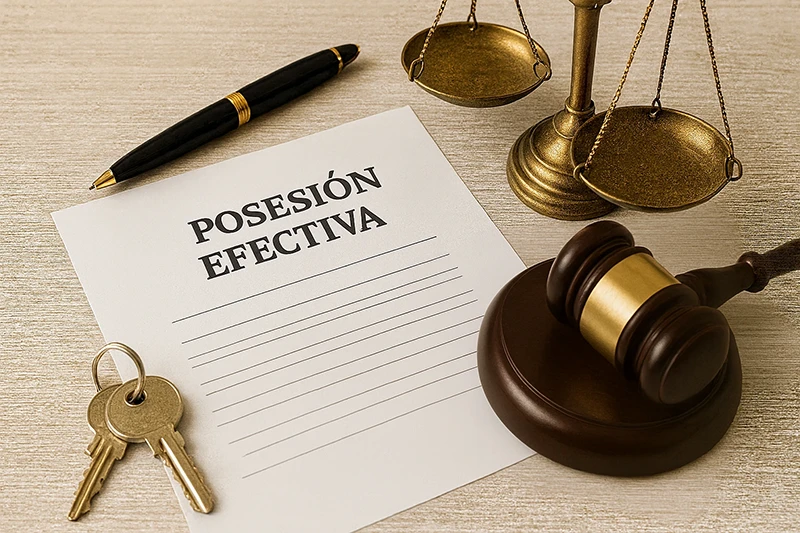Effective possession is the subsequent procedure that allows heirs to legally dispose of the property left by a deceased. It is an indispensable requirement in any inheritance, whether or not there is a will. In essence, effective possession officially determines who the heirs are according to the law (following the successive order of the Civil Code) and defines the distribution of property among them. It also enables heirs to register, sell, lease or divide these hereditary assets. For example, in the innermost succession the law establishes an order: first the children (or their descendants) together with the surviving civil spouse or partner, then ascending and spouse, then brothers and collateral, and finally (if there are no relatives) the State. This is formalized by the decision of effective possession issued by the relevant authority.
Legal regulation
Effective possession is regulated mainly by Act No. 19,903 (“Procedure for granting effective possession of inheritance”) and its regulations (D.S. 237 / 2004). The rules of the Civil Code (Book III, Successions) and the Code of Civil Procedure also apply. Other relevant laws include, for example, the Civil Marriage Act (No. 19,947, which provides for inheritance rights of the spouse), the Law on Inheritance Tax (Single Text of Act No. 16,271 and its amendments, such as Act No. 20,830) and Act No. 20,094 (on registration fees when registering property). Overall, this legal framework ensures that effective possession meets all formal requirements for the legal transfer of inherited property.
When do you need effective possession?
- As long as there is an inheritance. Without effective possession, heirs cannot legally transfer or dispose of the property of the deceased. All subsequent transactions (sale of houses, vehicles, etc.) require that the inheritance be formally processed.
- Inner inheritance (without will): it is handled administratively before the Civil Registry. He doesn’t need a lawyer. The Civil Registry itself advises the applicant and processes the application. This procedure is more expeditious and cost-effective than the court.
- Tested inheritance (with will): it must be tried in a civil court, usually by voluntary management before the judge of the deceased’s last home. In this case it is mandatory to have the sponsorship of a professional lawyer. The judge must verify the validity of the will and that the legal requirements are met, so this process is often more complex and long.
Procedure: Inner inheritance (Civil Registry)
An administrative procedure is carried out in the Civil Registration and Identification Service in accordance with Act No. 19,903 and its regulations. The main steps are as follows:
- Collect the required documentation: the effective possession form must be completed with all the basic data – data of the person (deceased), the applicant (who requests possession) and the heirs – and a detailed and valued inventory of goods. In practice this means to attach: a certificate of death of the perpetrator, birth and marriage certificates that demonstrate the family ties (of the deceased and the heirs), an affidavit of heirs and an inventory of the property (furniture and property, rights and debts) that the applicant himself makes in good faith. The applicant’s identity card is also presented. (In special cases, notarial powers, hereditary rights assignments, debt vouchers, etc.)
- Please submit the application: the form can be entered online (Civil Registry website) or on a face-to-face basis in any Civil Registry office (except hospital or malls services). The available form must bear the above information and the signature of the applicant. The form also considers a statement on the impact of inheritance taxes on allocations.
- Tariff payment: the cost depends on the total value of the declared assets (hereditary mass). In Chile, the Annual Tax Unit (UTA) is used to set ranges: if the hereditary mass is ≤ 15 UTA, the procedure is cost-free; between > 15 UTA and 45 UTA is paid 1.6 UTM; over 45 UTA is paid 2.5 UTM. (According to the rate in 2025 this is approximately 0, 1.6 or 2.5 monthly tax units.) The UTM (Monthly Tax Unit) is a tax account unit used in Chile to adjust amounts such as fines, taxes, taxes and tariffs according to inflation, based on the Consumer Price Index (CPI). The UTM is derived from the UTA (Annual Tax Unit), which is equivalent to the UTM in the last month of the year multiplied by 12. According to the Internal Tax Service (SII), as of July 2025: 1 UTM Ω $68,923 CLP, which matches if we multiply 68,923 × 12 = 827,076 CLP month July 2025:
- Resolution and publicity: with the full background, the Regional Director of the Civil Registry makes an administrative decision granting effective possession. This resolution is published once in a regional circulation journal (usually on 1 or 15 of the month). It is then automatically entered in the National Register of Effective Possessions of the Civil Registry, which generates an official certificate. The first certificate (which contains basic processing data) is free; the complete certificate is delivered to the heirs and has a moderate cost (for example, in ChileAtena it is mentioned about $1,250 CLP).
- Subsequent steps: obtained effective possession, heirs must liquidate and pay the inheritance tax to the Internal Tax Service (according to Law 16.271). They can then register the property in the name of succession: the property in the relevant real estate conservator and the vehicles in the Motorized Vehicle Register, as well as update any other record of property or rights (e.g. shares in companies, bank accounts, etc.). These procedures ensure that succession can legally dispose of every asset.
Procedure: proven inheritance (Civil court)
When the perpetrator left a valid will, effective possession is requested through voluntary judicial management before the appropriate Civil Letters Court (the last home of the deceased). The main steps are:
- Demand for effective possession with will: a lawyer submits to the competent court a proven application for effective possession. It must accompany the legalized copy of the will (or its protocolization), the death certificate, and generally a certificate of registration of the will (of the National Register of Testaments). It also includes an inventory of assets, which may be simple or solemn according to the value and complexity of the inheritance. At this stage, a lawyer may ask the Civil Registry for a report on legal heirs.
- Order of effective possession: after reviewing the background, the judge issues an order of effective possession, which is the court decision that recognizes the heirs (appointed in the will) and establishes the hereditary property. This order – different from a judgment in law – is the act that enables heirs to register, manage, sell or divide the property of the inheritance, in accordance with the will of the testament and the law.
- Tax payment: the declaration and payment of the inheritance tax is processed simultaneously with the Internal Tax Service (SII). The rules allow for this to be done online and usually have a period of up to 2 years after death to complete the settlement, after which a certificate of payment or exemption is obtained as appropriate.
- Publicity: Once signed, it is ordered to publish extracts of the order in the Official Journal or in regional newspapers (usually three consecutive times) to give publicity to the legal act. This step prevents fraud and allows third parties to present opposition before registration.
- Registration of effective possession: when the order is signed, the court officiates the Civil Registry for registration in the National Register of Effective Positions. In addition, the judge orders the special registration of inheritance in the real estate conservator where each property of the perpetrator is registered. For these inscriptions, documents similar to those of the administrative procedure must be provided: the court decision of effective possession (in force and certified), the certificate of the SII attesting the payment of the tax and certificates of tax avalano (and of non-debit of contributions in the TGR) for each declared property. In short, after obtaining the order and complying with the taxes, heirs follow similar procedures to the intact case: they publish extracts and write down the goods in the name of succession (vehicles, movable property, etc.).
Registration of real estate
Regardless of the route (administrative or judicial), where there is real estate in the estate, it is mandatory to register effective possession in the real estate conservator for the property. This is known as special inheritance registration. In practice, the decision (administrative or judicial) is presented to the conservator together with:
- Effective possession resolution (in force; if administrative decision, not more than 60 days of issue).
- Certificate of the SII attesting payment (or exemption) of the inheritance tax.
- Certificate of tax value of each building.
- Certificate of payment of municipal contributions (from the Treasury of the Republic).
The registration fee is set by Law 20.094 according to the hereditary mass: up to 15 UTA is not charged, between 15.01 and 45 UTA is paid 50% of the tax value, and over 45 UTA is paid 100% of the value. These ranges match the value sections used in the Civil Registry. When registering, the property becomes in the name of succession, which finally makes it possible to dispose of it (for example, to sell it).
Other associated costs
In addition to official tariffs, heirs must provide for other practical costs:
- Lawyer fees: No lawyer is required on the inside administrative track, but in practice many cases (especially if there are conflicts between heirs) are contracted. In the tried court, counsel is required. Legal fees are usually set at a percentage of the estate. In Chile, it is estimated that it is usually about 1 to 3% of the value of the hereditary mass. In guidance figures, in a basic process without a will, they could range from about $250,000 (small mass) to over $1,500,000 in higher-value inheritance.
- Certificates and publications: formal certificates and announcements are paid. For example, each publication of the extract in regional newspapers has a cost (approx. $25,000 CLP each notice). In addition, various certificates (from the Conservator, from the vehicle register, etc.) that may have small tariffs must be processed in the end. In general, there are additional associated administrative costs (notaries, certificate issuance, notice fees).
- Other records: any other registered asset requires its own processing. For example, to register vehicles in the name of succession in the Civil Register or to register company shares in the Trade Register. Only after all the above (effective possession and paid taxes) can heirs perform acts of disposition without legal problems.
Conclusion
Effective possession is a vital procedure for formalizing hereditary succession. It allows heirs to prove their quality and to dispose legally of the property of the deceased. There are two main ways: the administrative way, for innermost inheritance without will, processed before the Civil Registry (faster and more economical); and the judicial way, for proven inheritance with will, which requires a voluntary process in civil courts with a lawyer (more complex and expensive). In both cases, the process ends with the registration of the effective possession decision in the Real Estate Conservator (for real estate) and meeting all formal requirements (tax payments, publications, etc.), which enables heirs to legally sell, lease or transfer the inherited property. The procedure is regulated by Act No. 19,903 and its regulations, supported by the Civil Code and other relevant civil, tax and registration rules. In short, effective possession ensures that the transfer of inheritance complies with all the legal formalities required in Chile.
How can Produncan Lands help you with the Effective and Inheritance Tax Possession in Chile?
Facing the death of a loved one is never simple. In addition to this, the complexity of the legal procedures that allow heirs to dispose of the inherited property and to fulfil the corresponding tax obligations is added. In Produncan Lands we understand how difficult this process can be and therefore we offer comprehensive, clear and safe accompaniment.
- We guide the collection and preparation of documents required by the Civil Registry or the courts, as appropriate.
- We manage the submission of the application for effective possession, whether of innermost (no will) or tested (with will) inheritance.
- We accompany in the publications, inscriptions and subsequent formalities in the Real Estate Conservator and other records.
Why choose Produncan Lands?
- Updated knowledge of existing legislation.
- Experience in managing real estate and succession procedures.
- Close collaboration, always looking for clear and efficient solutions.
In Produncan Lands, we are concerned that this process, which is often complex and worn out, becomes a safe and transparent process, allowing the heirs to focus on the most important: honoring the memory of their loved ones and peacefully projecting the future. If you need help with the effective possession procedure contact us.


